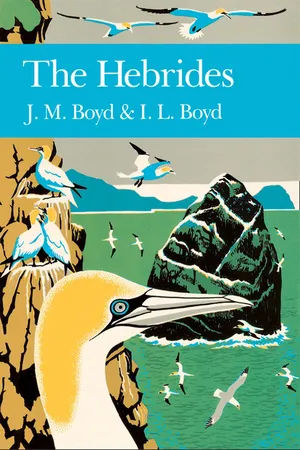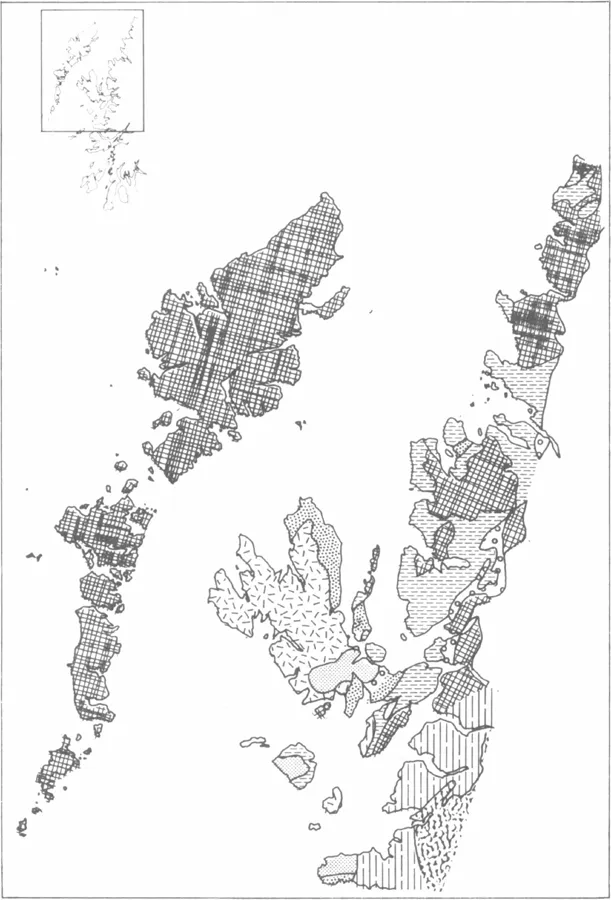![]()
PART I
The Ecosystem of the Hebrides
![]()
CHAPTER 1
Geology
What happens to us
Is irrelevant to the world’s geology
But what happens to the world’s geology
Is not irrelevant to us.
We must reconcile ourselves to the stones,
Not the stones to us.
Hugh MacDiarmid
Natural history starts with the elements of fire, earth, air and water all of which long pre-date life on the face of the Earth. No clear understanding of the origins and nature of life can be obtained without knowledge of the rocks, weather and conditions of the seas and freshwaters. It is on the interface between these elements that all life has sprung and been maintained throughout aeons of time, and nowhere is this truth more explicit than in an archipelago. There, among the islands, the grand relationship between land, sea and sky is obvious and makes a deep appeal to the human mind. Islands are a source of inspiration and happiness; their beauty is enshrined in a multitude of native island cultures all over the world and appreciated by historian, artist and scientist alike. The Hebrides are no exception. In them it is possible to trace the connections between these base elements and the lives of the wild creatures and human beings that spring from them, and to see the islands as one large system with its own in-built stops and balances in terrain, weather and ocean. Let us start with the rocks.
The span of geological time represented in the rocks of the Hebrides is almost as great as anywhere in the world. Though we know that planet Earth is some 4,600 million years of age, in human terms, the Lewisian gneiss formed some 3,000 million years ago is as old as time itself, while on the beds of the sea and the deep lochs the rocks of the future are being formed from the erosion products of by-gone glaciers, rivers and the sea. The cycle of regeneration and decay of hard rock seems timeless when compared with the timespan of human life.
In this vast interval of time, that part of the crust upon which the Hebrides now stand underwent a gradual transposition from tropical to temperate latitudes. Some ages of peace and tranquility are marked by the depositions of the sedimentary rocks: the Torridonian sandstone eroded from a range of mountains and deposited in predominantly desert conditions, 1,000 to 800 million years ago; the sandstones, shales and limestones of Cambro-Ordovician/Dalradian age, 600 to 450 million years ago; and the limestones and mudstones of the Jurassic, deposited in shallow lacustrine or estuarine conditions c. 150 million years ago (called not after the island of Jura, but the Jura Mountains in France).
Fig. 3 a & b Geological maps of the Outer and Inner Hebrides (Smith and Fettes, 1979, Craig (ed) 1983)
Between these periods of quiescence there were periods of profound crustal movement as blocks of continental crust fractured, jostled and were transported on plates of underlying crust, though the first of these hardly touches the Hebrides. During the Grenville mountain building about 1,000 million years ago, rocks which were probably the equivalent of the Torridonian strata far to the east of the present outcrops were compressed, deeply buried and heated in the crust, baked and altered to form the schists and metasandstones of the Moine Supergroup. These metamorphic rocks together with unaltered Torridian in turn formed a land surface on which were deposited limestones, shales and sandstones of Cambrian and early Ordovician age.
The second great upheaval was the Caledonian mountain building, 650 to 400 million years ago, when the rocks of the mainland were again folded and altered to form the rocks of mountains now occupying Scandinavia, Scotland and eastern USA. Moine rocks were heated and altered again, while Cambrian strata became the schists of the Dalradian Supergroup. Into the folded and refolded rocks, huge masses of molten crust were emplaced as granite, now widespread in the Highlands and represented in the Hebrides in the Ross of Mull. Along the western seaboard, however, rocks of the metamorphic mountains were thrust upwards and outwards in a dislocation of up to 80km. This is known as the Moine Thrust which runs on the land surface from Loch Eribol to the Point of Sleat in Skye. To the west of the Thrust, the Lewisian, Torridonian and Cambro-Ordovician rocks are in unmoved (and unaltered) sequence; to the east of the Thrust, within the Caledonian mountain belt, lie the Moines of Sleat and western Mull and the Dalradian of eastern Mull, Jura and Islay.
Fig. 4 The main geological faults of the Hebrides and West Highlands (Craig (ed) 1983)
The mountains formed from this orogeny were subsequently eroded to form the Old Red Sandstone (ORS) c. 350 million years ago, a vast continental fluviatile and lacustrine deposit. Orkney is composed almost entirely of ORS but only small outcrops occur in the Hebrides—sediments in Kerrera and Seil, and lavas at Loch Don in Mull.
The third upheaval was the rift of the European and Greenland continental plates which created the British Isles, the continental shelf and the Hebrides, but not as we know them today. This rifting, which began 70 million years ago and still continues today, was accompanied by much volcanic activity, the thrusting up of masses of gabbro and granite, the outblasting of vast quantities of dust, ash and cinder and the outpouring of basalt lavas. These are the Tertiary volcanic complexes of Arran, Mull, Ardnamurchan, Rum Cuillin, Skye Cuillin and St Kilda, with associated plateau lavas in North Skye, Canna, Eigg, Muck, West Mull and Morven. They are related to other such centres in Ireland (Giant’s Causeway), Faeroe Islands and Iceland, where the volcanic activity still continues. The islands as we know them today have been evolved through a northward drift of the crustal plate(s) of the planet from which the British Isles were formed, from a latitude of 30°S to the present latitude of 55°N. Throughout the drift, the palaeogeography was also continuously transformed by mounta...



